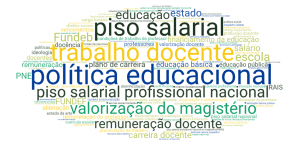ORIGINAL ARTICLE
LIMA, Leandro Jose Barbosa [1], HAMZAGIC, Miroslava [2], DINIZ, Maria Aparecida Campos [3]
LIMA, Leandro Jose Barbosa. HAMZAGIC, Miroslava. DINIZ, Maria Aparecida Campos. The use of digital information and communication technologies as a teaching and learning strategy. Revista Científica Multidisciplinar Núcleo do Conhecimento. Year. 07, Ed. 07, Vol. 04, p. 77-88. July 2022. ISSN: 2448-0959, Access link: https://www.nucleodoconhecimento.com.br/education/teaching-and-learning-strategy, DOI: 10.32749/nucleodoconhecimento.com.br/education/teaching-and-learning-strategy
ABSTRACT
The new scenarios imposed by globalization, added to the inclusion and universalization of education, in parallel with the new needs of Industry 4.0 and the evolution of society, have boosted the use of Digital Information and Communication Technologies (TDICs) in the educational environment. Therefore, this article sought to investigate: which Digital Information and Communication Technologies (TDICs) can contribute to the teaching and learning process? Thus, the objective was to present the TDIC of virtual and augmented reality, in addition to other TDICs that can contribute to this process. Therefore, a bibliographic research was carried out. As a result, the following technologies were pointed out: virtual reality; 3D prints; in addition to information platforms, as means that can contribute to the teaching and learning process. With this, it is concluded that these technologies are able to assist in the teaching and learning process, promoting greater interaction and engagement of students, in addition to learning.
Keywords: Didactics, Andragogy, Industry, Teaching.
1. INTRODUCTION
The learning process is not a static process, nor is it unilateral, but a multilateral process that depends on the interaction with others, on the individual’s experimentation with the content and on the growth of ideas through discussion among the learning participants (TAVARES et al., 2015).
Regardless of whether the space is virtual, physical or hybrid, interpersonal relationships will influence the effort and dedication of individuals in the group in relation to risk taking, which leads to learning (TAVARES et al., 2015).
Nobody teaches anyone, the learning process is an interactive process that depends on a well-defined work strategy and suitable for the public, to arouse the student’s interest and connections with the content (CARVALHO et al., 2010).
In this way, the learning environment must be collaborative and meaningful, so that the learner can identify a way to apply what is being studied in their daily lives, as well as make associations with their previous experiences and understand the practical importance of the learning process theme, remembering that it needs to be treated as the individual who is, free and responsible for self-management of learning (CARVALHO et al., 2010).
It is necessary for the teaching and learning process to cultivate critical and reflective thinking, to teach the individual to solve problems and to prepare him for life in society (GARCIA, 2009; PONGO et al., 2019).
The existence of new challenges and opportunities within the learning environment, which no longer works only in person, and can be presential, virtual or mixed, both in the school environment and in the industrial environment, brings to the subjects of the teaching action a need for adaptation with Digital Information and Communication Technologies (TDICs) and the development of new methods (ALMENARA et al., 2021; MEC, 2022).
That said, this article sought to investigate: which Digital Information and Communication Technologies (TDICs) can contribute to the teaching and learning process? Thus, the objective was to present the TDIC of virtual and augmented reality, in addition to other TDICs that can contribute to this process. Therefore, a bibliographic research was carried out, bringing studies related to the theme.
2. DIGITAL COMPUTER AND COMMUNICATION TECHNOLOGIES (TDICs) IN TEACHING AND LEARNING
Covid-19 accelerated the use of these technologies in education, causing educational institutions, teachers and students to adapt to new ways of teaching, with the use of Digital Information and Communication Technologies (TDICs) and with little curricular adaptation and democratic access to these new forms of teaching. In Brazil, the term used was ‘Emergency Remote Teaching’, which determined the virtualization of education through the migration of classroom teaching to online platforms, so that, although it was not something previously planned, the Information Technology area became extremely important for education (ALMENARA et al., 2021; HOLANDA et al., 2021).
In this context, the availability of technological artifacts such as cell phones, computers and tablets with internet access has become key to full access to education (ALMENARA et al., 2021; HOLANDA et al., 2021).
Therefore, although these new times have brought many difficulties, they have also provided some positive aspects that, in some way, were already present in the industry. Therefore, the first of them was the best preparation for the new industrial revolution, Industry 4.0, since students gradually become involved in Digital Information and Communication Technologies (TDICs) (EPPES; MILANOVIC and JAMSHIDI, 2021).
With this, TDICs made it possible to create new forms of learning, allowing more autonomy to the student and access to other educational institutions that were not accessible before, either for a geographical issue or for some other accessibility limitation (ALMENARA et al., 2021).
From the perspective of the teaching and learning process, it can be said that there are different strategies that can be used for the teacher’s work, namely: the dialogic expository class, brainstorming, the conceptual map, problem solving, study case, the panel, the forum, the workshop, the study of the environment and others. These are teaching strategies that bring with them different predominance of thought and dynamics of activity that can be applied in the teaching environment (ANASTASIOU and ALVES, 2005).
However, with regard to the new scenarios imposed by the imposition of digital skills, globalization, inclusion and universalization of education, the new needs of Industry 4.0 and the evolution of society, some technologies that were already present in the pre-Covid-19 context, but that were not yet fully developed in the educational environment, have become important teaching tools. Thus, through the isolation and social distancing measures, established for prevention, the covid-19 pandemic brought to the field of education the need to adapt with Digital Information and Communication Technologies (TDICs) and the development of new methods (ALMENARA et al., 2021; MEC, 2022) that would enable interactive teaching, despite the distances.
Thus, among the possibilities of teaching strategies, we can highlight the use of virtual, augmented or mixed reality, which consist of technologies that allow the experience of some situations, which would otherwise be impossible due to the distance issue, such as the use of laboratory or visit to industrial environments, museums, etc.
In this context, Virtual Reality (something totally closed where the individual does not have the visualization of his surroundings), allows the sensation of immersion in an environment, which includes the audio. Augmented Reality, in turn, adds digital elements to the real world and allows the user to receive information from what he is observing. While Mixed Reality gives the user the same experience as Augmented Reality, however, it allows interaction with the digital elements introduced to the environment (IMAM, 2020; WYSS et al., 2021; AZEVICH, 2019).
In this context, these solutions have great potential, not only because they increase the students’ experience, but also because they allow contact with fictitious objects without the need to take risks or put others at risk, completely dispensing with travel expenses (IMAM, 2020; WYSS et al., 2021; AZEVICH, 2019).
Therefore, as examples of applications, the example of the American army that used 40 thousand devices like this Mixed Reality to train its personnel is mentioned. In addition, NASA has been using Virtual Reality for years to acclimatize their personnel, and they already use Mixed Reality programs for the purpose of caring for the mental health of astronauts on mission. A group of Milan researchers used Mixed Reality to treat people with Alzheimer’s who were suffering from memory loss. Yet another use of Mixed Reality was in London hospitals, to avoid the use of too many staff inside Covid-19 patient treatment rooms, thus making it difficult for other staff members to be contaminated. Likewise, this technique has been used in medical courses to train students in surgeries, autopsies and diagnoses (Figure 1). This type of Mixed Reality has served to enable emergency response teams to prepare to act in real situations (IMAM, 2020). In this aspect, despite the distance, TDICs also allow physical collaborative work through the internet. For example, there was once an occasion when scientists could manipulate the same protein from a distance (WYSS et al., 2021).
Figure 6 – Illustrative image of Microsoft HoloLens
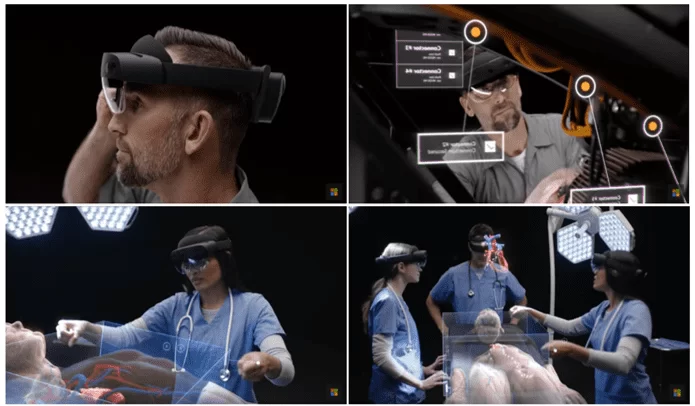
Therefore, according to Correia and Bertolini (2022)
As inovações que essas tecnologias trazem são capazes de divertir os estudantes e fazer com que tenham mais vontade de aprender. Essas inovações fazem com que eles tenham mais interesse e engajamento no transcurso do aprendizado, posto que é uma metodologia inovadora e criativa. As imagens virtuais tridimensionais e a imersão em um mundo virtual possibilitam um entendimento mais aprofundado sobre a matéria estudada e aguça a memória visual do educando, auxiliando no processo de fixação do conteúdo.
However, it should be noted that these technologies are not widely available. In some cases, they present a high cost, can generate distractions, require pre-work of video, scenarios and content. They may work with cell phones, but depend on each student’s cell phone hardware. Equipment, when shared, requires cleaning, in addition to needing additional care in relation to the place of use to avoid risks of falls or other safety risks due to the space required around the learner (WYSS et al., 2021; AZEVICH, 2019).
Thus, one of the simplest solutions, which can be very economical and which is already common for many students is Google Cardboard®, which concerns a virtual glasses, launched in 2014 by Google, built with cardboard, biconvex lenses with the 4.5 cm focal length and magnets. The smartphone is attached to it and a specific mobile application is installed for Virtual Reality to take place. Through these glasses it is possible to view images reproduced in 3D, games that simulate a virtual environment that interact with the movements captured by the accelerometer and the gyroscope of the cell phone itself (FURTADO and NUNES, 2021, p. 178).
Figure 2 – Google Cardboard®

However, this can also be prepared by the student himself, using cardboard, assuming a homemade version of Google Cardboard, as can be seen in Canal Manual do Mundo.
Figure 3: Home version of Google Cardboard®
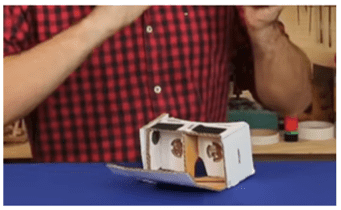
Therefore, it allows student interaction, since Virtual Reality, Augmented Reality and Mixed Reality modes can be experienced (MANUAL DO MUNDO, 2015; CANALTECH, 2016).
Of course, this is not a single or definitive solution to assist in the educational process, but it is an extra resource that has added value in training people around the world (IMAM, 2020; WYSS et al., 2021; AZEVICH, 2019). It is also an inclusive solution, as it allows users with mobility difficulties to experience the world like other professionals.
On the other hand, the different types of reality are not the only types of technologies that allow the student to interact with the environment, it is also possible to use additive manufacturing in education, also known as 3D printing.
A tecnologia de impressão 3D tem sido usada no ensino primário e secundário em projetos de ciência, tecnologia, engenharia e matemática. Há um otimismo que ela terá um grande impacto na educação. Bull e Groves (2009) escreveram: “Como ferramentas de fabricação, tornam-se cada vez mais acessíveis; estudantes serão capazes de aprender sobre engenharia e experimentar a emoção de ver suas ideias realizadas de forma física.” (KNILL e SLAVKOVSKY, 2013a, p. 13, tradução nossa).
In this aspect, the costs of these equipments have also been reduced drastically. Below is an example of a 3D model that could be prepared by the students of the course or by the teacher himself and the current cost of a 3D printer.
Figure 10 – 3D printed model
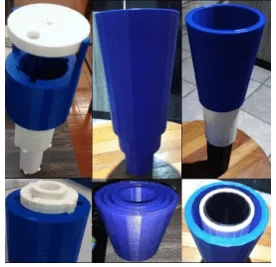
Figure 11 – 3D Printer
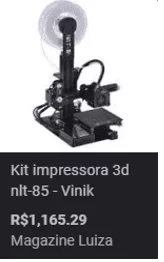
Therefore, it is understood that 3D printing could also be used for teaching, either by teachers, who prepare materials to exemplify in the classroom, or by students, so that they can test their theories or grope an object to better understand a subject idea (LOPES et al., 2018).
However, Digital Information and Communication Technologies (TDICs) are not limited to devices, but also to new information platforms, such as Google®, LinkedIn®, ResearchGate®, Academia® and communication systems such as Google Meet®, Skype®, Whatsapp®, Microsoft Teams®, among others that enable communication between student and teacher in educational institutions.
In view of this, it is important that the individual, in addition to being stimulated, will have active, and not passive, participation in the learning process. The brain needs time to assimilate concepts and establish synapses, which takes time and practice (GARCIA, 2009; HOBOLD, 2018). It is not possible to transfer knowledge to someone else, but rather to awaken in them the desire to learn, and this desire leads to the assimilation of knowledge(CARVALHO et al., 2010).
3. FINAL CONSIDERATIONS
Based on this research, it was observed that the existence of new challenges and opportunities for the educational context, so that digital skills became mandatory for students, teachers, industries and educational institutions, accelerating the context already experienced by society of Industry 4.0, but now being a context of Education 4.0. In this, the insertion of TDICs in the context of education for the improvement of the teaching and learning process is increasingly observed.
That said, this article sought to investigate: which Digital Information and Communication Technologies (TDICs) can contribute to the teaching and learning process? Therefore, the objective was to present virtual and augmented reality TDICs, as well as other TDICs that can contribute to this process.
Therefore, through bibliographic research, the following technologies and their contributions can be highlighted: virtual reality, augmented or mixed, allows the visualization of three-dimensional virtual images, promoting greater desire for learning in students and content fixation by stimulating visual memory ; 3D printing can be used to develop teaching materials and to test structural theories, among others; in addition to information platforms, which allow greater interaction between student and teacher in educational institutions.
REFERENCES
ALMENARA, J. C. et al. University Teaching in Times of Pandemic. Reflection on the digital skills of Spanish university teachers according to DigCompEdu Framework. Revista da Escola Superior de Educação, p. 28-34, 2021.
ANASTASIOU, L. das G. C.; ALVES, L. P. Processos de ensinagem na universidade: Pressupostos para as estratégias de trabalho em aula. 5. ed. Joinville, SC: UNIVILLE, 2005.
AZEVICH, A. I. Virtual reality: educational and methodological aspects. RUDN Journal of Informatization in Education, v. 16, n. 4, p. 338-350, 2019.
CANALTECH. Google Cardboard: você conhece esse dispositivo? [Hands-on]. Canaltech, Dezembro de 2016. Disponível em: https://canaltech.com.br/video/hands-on/google-cardboard-voce-conhece-esse-dispositivo-hands-on-5138/. Acesso em: 15 jul. 2022.
CARVALHO, J. A. D. et al. Considerações sobre a Aprendizagem do Adulto. Ensino, Saúde e Ambiente, v.3 n.1 p. 78-90, 2010.
CORREIA, A. J. R.; BERTOLINI, C. Realidade virtual e aumentada como metodologia na educação. Trabalho de Conclusão de Curso, Licenciatura em Computação EaD – UAB, Universidade Federal de Santa Maria, 2022.
EPPES, T.; MILANOVIC, I.; JAMSHIDI, R. Engineering Curriculum in Support of Industry 4.0. International Journal of Online and Biomedical Engineering (iJOE), v. 17, n. 01, p. 4-15, 2021.
FURTADO, P. G. R.; NUNES, P. C. O uso da realidade virtual no processo de ensino-aprendizagem da reação de combustão. Revista Ciências & Ideias, v. 12, n. 1., 2021.
GARCIA, J. Avaliação e Aprendizagem na Educação Superior. Estudos em Avaliação Educacional, v. 20, n. 43, p. 201-213, 2009.
HOBOLD, M. S. Desenvolvimento profissional dos professores: aspectos conceituais e práticos. Práxis Educativa, v. 13, n. 2, p. 425-442, 2018.
HOLANDA, R. R. et al. Educação em tempos de COVID-19: A emergência da educação a distância nos processos escolares da rede básica de educação. HOLOS, v. 3, p. 1–15, 2021.
IMAM, M. Changing the Paradigm of Mixed Reality (MR) in: Education Sector through Microsoft HoloLens. International Journal of Scientific & Engineering Research, v. 11, n. 12, p.1328-1333, 2020.
KNILL, O.; SLAVKOVSKY, E. Thinking like Archimedes with a 3D printer. ArXiv, 2013a, 16 p.
LOPES, T. G. et al. A Utilização de Manufatura Aditiva em Projetos de Pesquisa. In: Anais do II Congresso de Inovação e Tecnologia – FATEC, Lajeado, p. 104-112, 2018.
MANUAL DO MUNDO. Como fazer o óculos de realidade virtual caseiro – Como fazer o GOOGLE CARDBOARD. Youtube, jul. de 2015.
MEC. Tecnologias Digitais da Informação e Comunicação no contexto escolar: possibilidades. Base Nacional Comum Curricular, 2022. Disponível em: http://basenacionalcomum.mec.gov.br/implementacao/praticas/caderno-de-praticas/aprofundamentos/193-tecnologias-digitais-da-informacao-e-comunicacao-no-contexto-escolar-possibilidades?highlight=WyJocSJd. Acesso em: 3 mai. 2022.
MICROSOFT. Introducing Microsoft HoloLens 2. [S.l.]: Microsoft HoloLens, 2019. 1 vídeo (1:34). Disponível em: https://www.youtube.com/watch?v=eqFqtAJMtYE. Acesso em: 3 mai. 2022.
PONGO, N. A.; OBINIM, E.; ZANU, J. A. An Evaluation of Creative and Vocational Education and the Changing Demands of Industry Competencies. Fashion and Textiles Reviews, v.1, 1 ª ed., p. 1-9, 2019.
TAVARES, P. S. A. et al. Diferentes experiências em contextos de trabalho: interações socioculturais. Revista Ciências Humanas – UNITAU, v. 8, n.1, 14ª ed., p.70-80, 2015.
WYSS, C. et al. Innovative teacher education with the augmented reality device Microsoft Hololens—results of an exploratory study and pedagogical considerations. Multimodal Technologies and Interaction, v. 5, n. 8, p. 45, 2021.
[1] Graduated in Petroleum Engineering from Universidade Estácio de Sá (UNESA), and Graduated in Mechanical Technology with emphasis in Industrial Automation from CEFET/RJ. Master in Mechanical Engineering from the University of Taubaté (UNITAU), MBA in Business Management from Fundação Getúlio Vargas (FGV), MBA in Project Management from the Foundation supporting CEFET/RJ, Specialist in Occupational Safety Engineering from Universidade Candido Mendes ( UCAM), Specialist in Petroleum Engineering from Universidade Estácio de Sá (UNESA) and certified Radioprotection Supervisor by CNEN. ORCID: 0000-0002-6647-3914.
[2] Graduated in Architecture and Urbanism from the University of Taubaté, UNITAU, with a postgraduate degree in Marketing Management and Occupational Safety Engineering from the Polytechnic School of Pernambuco. Master in Regional Development Management from UNITAU and PhD in Production Engineering from Escola Politécnica da USP. ORCID: 0000-0001-8082-5763.
[3] Advisor. Graduated in Pedagogy, Master in Education (Educational Psychology), PhD and Post-Doctor in Education: Educational Psychology, from the Pontifical Catholic University of São Paulo. ORCID: 0000-0002-9844-0287.
Sent: April, 2022.
Approved: July, 2022.















